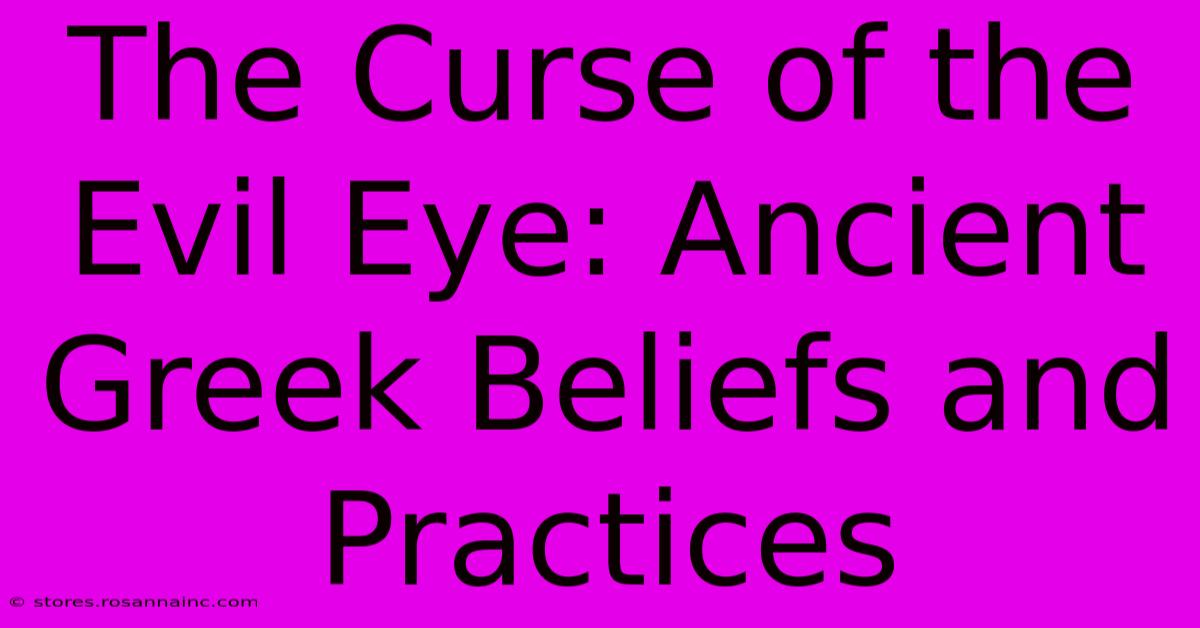The Curse Of The Evil Eye: Ancient Greek Beliefs And Practices

Table of Contents
The Curse of the Evil Eye: Ancient Greek Beliefs and Practices
The Evil Eye, or matiasma (μάτιασμα) in Greek, wasn't merely a superstition in ancient Greece; it was a deeply ingrained belief woven into the fabric of daily life. Fear of its potent curse permeated society, leading to widespread practices designed to protect against its malevolent influence. This article delves into the ancient Greek understanding of the Evil Eye, exploring its origins, effects, and the various protective measures employed to ward off its baleful gaze.
Understanding the Ancient Greek Evil Eye
The core belief centered around the power of envious glances. It wasn't simply negative feelings; the matiasma was believed to be a tangible force emanating from someone's envious eye, capable of inflicting harm—physical illness, misfortune, or even death—on the unsuspecting victim. This wasn't limited to intentional malice; an unintentional, envious gaze could also unleash the curse. This explains the widespread prevalence of protective amulets and charms.
The Vulnerable and the Envious
Certain individuals were considered more vulnerable to the matiasma: babies, children, and those experiencing good fortune were prime targets. Their perceived vulnerability stemmed from their innocence and lack of personal protective power. Conversely, the envious were seen as those most likely to cast the evil eye, often out of resentment or jealousy towards another's success, beauty, or prosperity.
Manifestations of the Curse
The effects of the matiasma weren't always immediately apparent. Symptoms could manifest in various ways, ranging from mild discomfort and illness to more severe conditions. These could include:
- Sudden illness: Unexplained fevers, stomach aches, or general malaise were often attributed to the Evil Eye.
- Misfortune: A string of bad luck, financial setbacks, or relationship problems were also considered potential signs.
- Withdrawn behavior: In children, the matiasma might manifest as unusual lethargy or irritability.
Protective Measures and Amulets
Ancient Greeks developed a rich array of protective measures against the Evil Eye. These practices were designed to either prevent the curse from being cast or to counteract its effects once inflicted.
Apotropaic Symbols and Amulets:
These objects, believed to possess protective powers, were incredibly popular. Some common examples include:
- The Hand of Fatima (Hamsa): Though often associated with Islam, variations of this protective hand symbol were used in ancient Greece and other Mediterranean cultures.
- Evil Eye Charms (Mati): These iconic blue glass beads, often depicted as a stylized eye, were perhaps the most prevalent protective amulet. Their bright blue color was thought to reflect and deflect the malevolent gaze.
- Religious Symbols: Images of gods and goddesses, particularly those associated with protection and healing, were also frequently used.
Rituals and Practices:
Beyond amulets, various rituals were employed to combat the Evil Eye:
- Spitting: Spitting three times was a common gesture believed to ward off the curse.
- Incantations and Prayers: Specific prayers and incantations were recited to invoke divine protection.
- Making the Sign of the Cross: Similar to spitting, this act was performed to counteract the negative energy.
The Evil Eye in Modern Greece
While modern Greece may not explicitly ascribe to the same level of belief as their ancient counterparts, remnants of the fear of the Evil Eye persist. The use of mati charms remains common, especially for protecting children and newborns. This enduring legacy highlights the deep-seated nature of this ancient belief and its enduring cultural impact. The fear of the Evil Eye, however, is far from unique to Greece. Similar beliefs and practices are found across many cultures, highlighting the universal human fear of unseen harm and the enduring power of protective beliefs.
Keywords: Evil Eye, Matiasma, Ancient Greece, Greek Mythology, Ancient Greek Beliefs, Apotropaic Symbols, Amulets, Protective Charms, Hamsa, Hand of Fatima, Mati, Superstition, Curse, Ancient Greek Culture, Greek History, Protective Measures, Rituals, Beliefs, Practices
This article aims to provide a comprehensive overview of the subject, utilizing relevant keywords for improved search engine optimization and incorporating various heading levels for better readability and structure. The use of bold text and bullet points enhances the overall presentation and comprehension for the reader.

Thank you for visiting our website wich cover about The Curse Of The Evil Eye: Ancient Greek Beliefs And Practices. We hope the information provided has been useful to you. Feel free to contact us if you have any questions or need further assistance. See you next time and dont miss to bookmark.
Featured Posts
-
The Power Of Worshiped Unlocking The Transformative Impact On Our Lives
Feb 06, 2025
-
Unveiled The Hidden Secret Behind Bohemian Green Floral Bouquets Price Tag
Feb 06, 2025
-
Elimina El Texto De Cualquier Imagen En Segundos Y Gratis
Feb 06, 2025
-
Come Comprimere Immagini Per Caricamenti Online In Pochi Secondi Una Guida Per Principianti
Feb 06, 2025
-
Experience The Art Of Contemporary Living 50 South Fourth Street Henderson Nvs Architectural Masterclass
Feb 06, 2025
